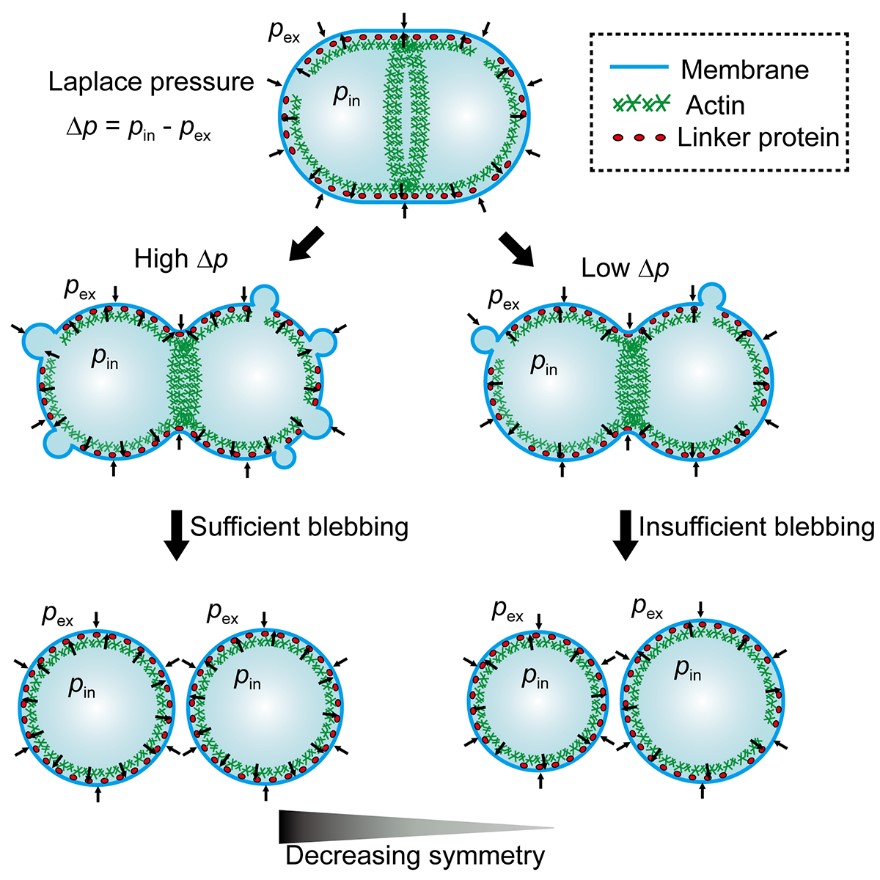The Laplace pressure of the cells, which is the difference between intracellular and extracellular pressures, is generated by water fluxion caused by cell osmolarity change or cortex contraction. The Laplace pressure is one of the most fundamental regulators that determine cell shape and function, and thus has been receiving widespread attention. When cells enter into mitosis, the Laplace pressure undergoes a more than 10-fold change. The elevated Laplace pressure induced by increased intracellular osmolarity is the main cause of cell rounding at mitotic entry; after that, the constriction of both the contractile ring and the polar cortex during cytokinesis contribute to the increase of the Laplace pressure, which is deemed to functionally play a dual role: acting as resistance force to antagonize the contractile ring early in cytokinesis while helping to drive furrow ingression late in cytokinesis. However, despite the increasing appreciation of physiological significance of this transmembrane pressure, the effects of the Laplace pressure on the cytokinesis process have been still poorly understood so far.
Researchers from the Institute of Mechanics, Chinese Academy of Sciences systematically studied the effect of the Laplace pressure on the cytokinesis process by controlling the extracellular osmolarity to adjust the intracellular pressures of the cells, thus, to regulate their Laplace pressures. First of all, they find that the Laplace pressure can directly control the distribution and size of cell blebbing during cytokinesis: the larger the Laplace pressure of a cell during cytokinesis is, the sooner the blebbing activity completes, at the same time, the fewer the mean number of blebs is and the larger the mean size of blebs is. Further, they demonstrate that the variation of the Laplace pressure of a cell during cytokinesis changes the symmetry of cell division: the larger the Laplace pressure is, the more symmetric the newborn daughter cells are. Finally, they give the mechanism that the Laplace pressure adjusts the symmetry of cell division by virtue of changing the cell blebbing during cytokinesis: the Laplace pressure changes the structural uniformity of cell boundary by virtue of cell blebbing to regulate the symmetry of cell division (Fig. 1). Their findings provide further insights as to the important role of the Laplace pressure in regulating the symmetry of cell division during cytokinesis, and contribute to a deeper understanding of the essential role of the Laplace pressure in cellular life processes.
This work entitled “Effects of the Laplace Pressure on the Cells during Cytokinesis” has been published in Iscience (2021, 24: 102945).
The paper link: https://www.sciencedirect.com/science/article/pii/S2589004221009135?via%3Dihub
This work has been supported by the National Natural Science Foundation of China (Grant Nos. 11972041 and 11902327), Youth Innovation Promotion Association CAS, the Strategic Priority Research Program of the Chinese Academy of Sciences (Grant No. XDB22040102).

Figure 1. High Laplace pressure helps to ensure symmetric cell division.